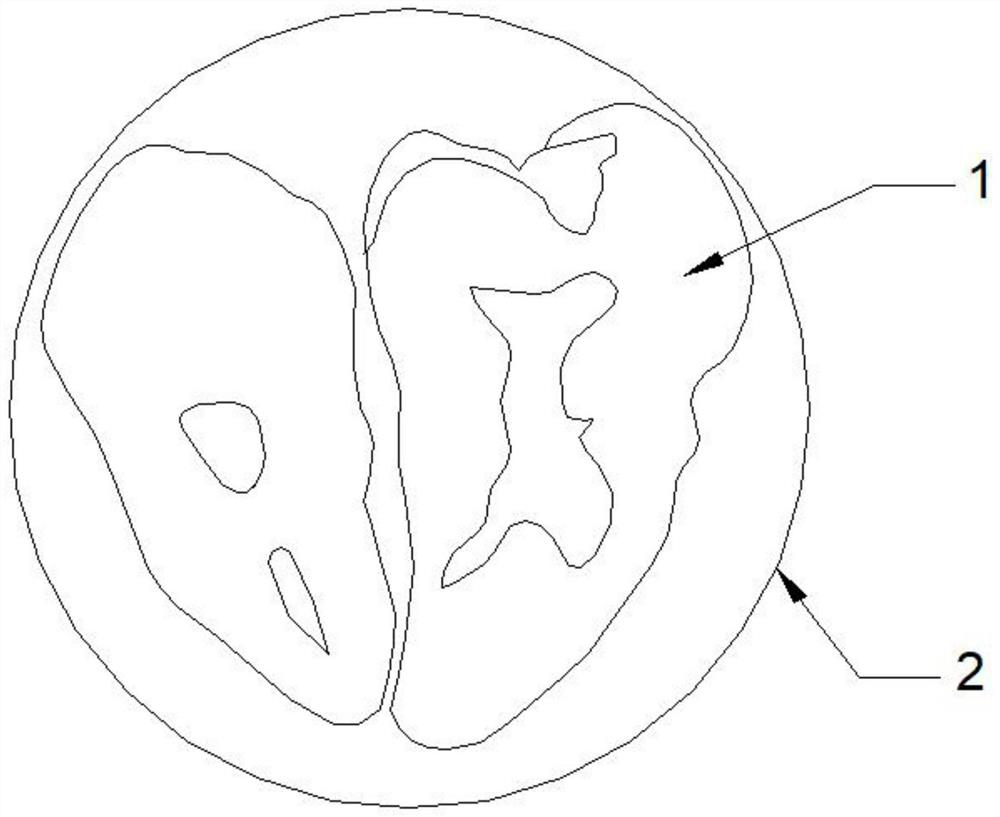Super-clear visual field diseased tooth specimen and preparation method thereof
A field of vision and specimen technology, applied in the field of diseased tooth specimens and their preparation, can solve problems such as rigid forms
- Summary
- Abstract
- Description
- Claims
- Application Information
AI Technical Summary
Problems solved by technology
Method used
Image
Examples
Embodiment 1
[0038] see figure 1 , this embodiment discloses a diseased tooth specimen with an ultra-clear field of view, including a diseased tooth 1, a glycerol layer and an ultra-clear epoxy resin ab crystal colloid 2 that sequentially cover the surface of the diseased tooth 1 from the inside to the outside, bacteria of the diseased tooth 1 The infection-type lesion structure is processed in at least one of full section, half section and partial section, and the non-bacterial infection type lesion structure of the diseased tooth 1 is processed by fenestration.
[0039] In an optional embodiment, the diseased tooth specimen in the ultra-clear field of view has a hemispherical structure, and the observer can observe the spherical vertical position under conventional illumination to obtain preliminary disease information. During the observation, the shape and color of the lesion structure can be seen with a magnification of about 0.5-1 times; since the distance from the spherical surface t...
Embodiment 2
[0049] A method for preparing a diseased tooth specimen with an ultra-clear field of view, comprising the following steps:
[0050] S10, selecting an isolated tooth with a bacterial infection-type diseased structure and a non-bacterial infection-type diseased structure as the diseased tooth 1, and soaking, cleaning and bleaching the diseased tooth 1;
[0051] In S10, bacterial infection-type lesions include: periodontal calculus, dental plaque; caries deep caries, superficial caries, pit and fissure caries, surface demineralization infection; dental pulp infection; restoration bonding agent residues.
[0052] In S10, non-bacterial lesions include cracked teeth, fissures, occlusal wear, dental fluorosis, non-carious dental defects, deformed teeth, secondary dentin, pulp calcification, and teeth with fillings , Restoration of crown teeth.
[0053] In S10, after the teeth are separated from the body, do not squeeze or wipe the teeth, keep the tooth tissue clean, use hydrogen pe...
Embodiment 3
[0082] Based on the diseased tooth specimen of a kind of ultra-clear visual field of embodiment 2, its observation method is as follows:
[0083] In clinical teaching, the observer wears goggles that isolate 190nm-540nm OD6, or uses an eye protection observation screen that can block blue-violet electromagnetic waves, and uses 405nm excitation light that can conically diverge beams. For example, patent number: 2019111926976, patent Name An instrument to aid in the visualization of periodontal treatment, projected into the viewing surface of the hemispherical lens specimen at an oblique angle of about 30-60 degrees.
[0084] In clinical teaching, the 405nm excitation light that forms a cone-shaped divergent beam is selected to irradiate the bacteria-infected tooth 1. After the bacteria-containing diseased tissue absorbs the purple electromagnetic wave, it produces pink fluorescence at 632 nm; after the tooth hard tissue absorbs the purple electromagnetic wave, it produces green ...
PUM
 Login to View More
Login to View More Abstract
Description
Claims
Application Information
 Login to View More
Login to View More - R&D
- Intellectual Property
- Life Sciences
- Materials
- Tech Scout
- Unparalleled Data Quality
- Higher Quality Content
- 60% Fewer Hallucinations
Browse by: Latest US Patents, China's latest patents, Technical Efficacy Thesaurus, Application Domain, Technology Topic, Popular Technical Reports.
© 2025 PatSnap. All rights reserved.Legal|Privacy policy|Modern Slavery Act Transparency Statement|Sitemap|About US| Contact US: help@patsnap.com

